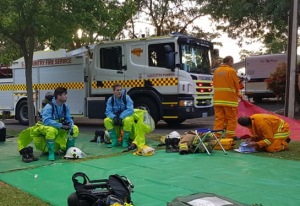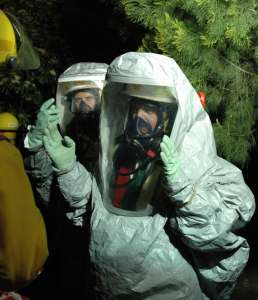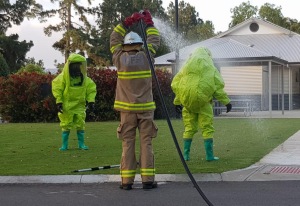
This work is licensed under a Creative Commons Attribution-ShareAlike 4.0 International License

HAZardous MATerials spills and decontamination


Hazardous Material (HAZMAT) incidents are the result of a spillage of some type of chemical or substance which is unknown. A HAZMAT incident requires the spilled substance to be identified, neutralised, and contained, and then the affected area decontaminated.
Although the concepts sound simple enough, in practice, these can be difficult and dangerous. The complexity, nature and difficulty of the incident are very hard to gauge until the spill is discovered and the substance identified. This is further compounded if the spill is the result of a fire or road accident, or a large volume of material is spilt.
HAZMAT incidents are renowned for their often protracted time and large resource requirements. Whilst all CFS volunteers are trained to identify these types of incidents and basic incident isolation procedures, only a few brigades in each region are specifically trained in HAZMAT. HAZMAT units may not be the closest unit to the spill, and further specialist equipment may have to be obtained from other areas, further prolonging the incident and decontamination effort.
HAZMAT training is very specialised, with the equipment just as specialised and extremely expensive. HAZMAT incidents are regarded as the most costly type of incident due to their low incident volume and high equipment and training cost. Local HAZMAT brigades are equipped with front-line HAZMAT equipment including containment bags, chemical resistant splash-suits and boots, chemcial detection equipment, additional Breathing Apparatus sets and chemical leak repair kits.
At any HAZMAT incident, crews must isolate the area, to keep crews and the public away from hazardous materials, and identify the material. The 'dirty' or contaminated area is clearly separated from the 'clean' or uncontaminated area. One area is set aside as the decontamination area, which is used to clean any residual material off firefighters, once they have completed their task at the spill.
 Firefighters wearing Breathing apparatus, and within a chemical 'splash' suit, with helmet, PVC gloves and boots enter the contaminated area, and endeavour to normalize the area. It may be that a solid material is shovelled up and placed in suitable drums, split containers picked up and placed in appropriate drums, material hosed down and diluted with water, or a neutralizing agent placed on the spilt material. The action taken depends on the chemical behaviour of the material, and takes into account things like watercourses, (creeks, drains, dams) populated areas, etc.
Firefighters wearing Breathing apparatus, and within a chemical 'splash' suit, with helmet, PVC gloves and boots enter the contaminated area, and endeavour to normalize the area. It may be that a solid material is shovelled up and placed in suitable drums, split containers picked up and placed in appropriate drums, material hosed down and diluted with water, or a neutralizing agent placed on the spilt material. The action taken depends on the chemical behaviour of the material, and takes into account things like watercourses, (creeks, drains, dams) populated areas, etc.
Once the firefighters have finished their task, or have run low on air, they must be decontaminated before they can get out of their chemical suits, and out into the 'clean' area.
Decontamination may be done with water, either by hosing down the firefighter, or going under a specifically designed shower. Some chemicals should not come into contact with water, and thus a 'Dry Decontamination' is undertaken. This may involve firefighters being vacuumed off with a special vacuum cleaner.
Once the firefighter has been decontaminated, they can move into the 'clean' area, for a rest and a drink!
 Only firefighters in clothing and equipment appropriate for dealing with the chemicals may move into the 'dirty' or contaminated area. Should members of the public, or other services move into the dirty area, without appropriate protective clothing, they too must be decontaminated, in the same way the firefighters do, but without the benefit of a protective suit!
Only firefighters in clothing and equipment appropriate for dealing with the chemicals may move into the 'dirty' or contaminated area. Should members of the public, or other services move into the dirty area, without appropriate protective clothing, they too must be decontaminated, in the same way the firefighters do, but without the benefit of a protective suit!
Photographs on this page taken by the CFS Promotions Unit and Nuriootpa CFS







